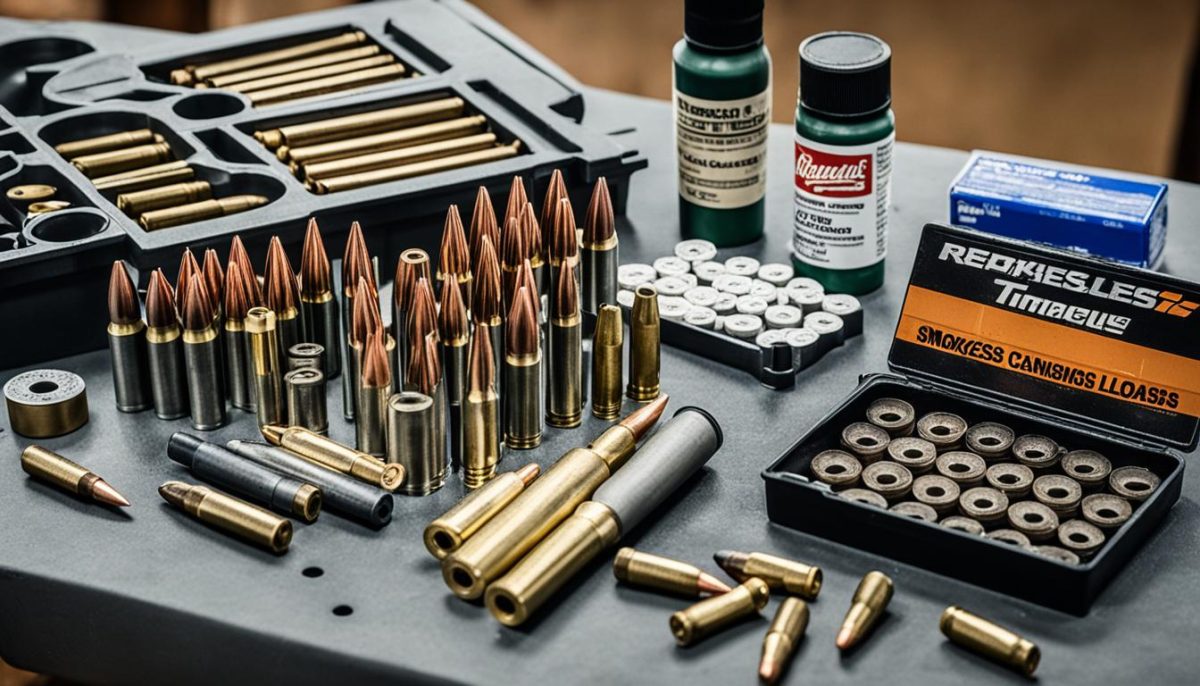In this comprehensive guide, we’ll explore the world of 40-65 smokeless loads, delving into the fundamentals, component selection, and fine-tuning techniques to help you achieve optimal performance in your hunting and target shooting endeavors. Whether you’re a seasoned reloader or new to the game, this article will provide you with the insights and practical knowledge to master the 40-65 cartridge and take your shooting to new heights.
Understanding the Fundamentals of 40-65 Smokeless Loads
As passionate shooters and reloaders, we know that understanding the fundamentals of 40-65 smokeless loads is key to unlocking their full potential. These cartridges have long been a favorite among hunters and sport shooters, prized for their ballistic performance and versatility. In this section, we’ll dive into the details of what 40-65 smokeless loads are and why proper load development is so crucial.
What are 40-65 Smokeless Loads?
The 40-65 cartridge is a classic Winchester design that has been around for well over a century. Chambered in a variety of rifles, it utilizes a .40-caliber bullet propelled by smokeless powder. This combination offers a potent blend of power and accuracy, making it a popular choice for medium-sized game and long-range target shooting.
At the heart of the 40-65 cartridge are several key components: the case, primer, powder, and bullet. Each of these elements plays a crucial role in determining the overall performance and safety of the load. Careful selection and precise measurement of these components are essential for achieving optimal ballistics and ensuring a safe, consistent shooting experience.
The Importance of Proper Load Development
Load development is the process of meticulously testing and fine-tuning a specific ammunition load to maximize its performance and safety. This process is particularly important for the 40-65 cartridge, as it allows shooters to find the perfect balance between power, accuracy, and pressure.
By experimenting with different powder charges, bullet weights, and other variables, reloaders can create custom loads that are tailored to their specific firearm and shooting requirements. This level of personalization can lead to significant improvements in downrange performance, whether you’re hunting, competing, or simply enjoying a day at the range.
Moreover, proper load development helps ensure the safety and reliability of your 40-65 ammunition. Overloading or using the wrong components can lead to dangerous pressure spikes or even catastrophic failures. By taking the time to develop your loads carefully, you can avoid these risks and enjoy a safe, enjoyable shooting experience.
Understanding the fundamentals of 40-65 smokeless loads is the first step towards unlocking their full potential. By knowing the key components and the importance of load development, you’ll be well on your way to creating custom loads that deliver exceptional performance and reliability. In the next section, we’ll explore the process of choosing the right components for your 40-65 smokeless loads.
Choosing the Right Components for 40-65 Smokeless Loads
When it comes to crafting the perfect 40-65 smokeless loads, the selection of reloading components is crucial. From powder and bullet choices to the right case and primer, each element plays a vital role in ensuring consistent performance, accuracy, and safety. In this section, we’ll guide you through the process of selecting the optimal components for your custom 40-65 smokeless loads.
Powder Selection for 40-65 Reloading
The choice of powder is one of the most important decisions in 40-65 reloading. Factors such as burn rate, pressure characteristics, and velocity potential must be carefully considered. Slow-burning powders like H4831 and IMR4350 are popular options, as they provide the necessary energy and consistency for the 40-65 cartridge. However, it’s essential to work within the recommended load data to maintain safe pressure levels.
Bullet Selection for 40-65 Reloading
Selecting the right bullet for your 40-65 smokeless loads can significantly impact downrange performance. Heavier bullets, such as those in the 300-400 grain range, often provide the best balance of ballistic coefficient, sectional density, and terminal energy. Premium hunting bullets with advanced designs, like those from Barnes or Nosler, can deliver exceptional accuracy and penetration. Always reference the manufacturer’s recommendations to ensure safe and reliable results.
| Reloading Component | Recommended Options |
|---|---|
| Powder | H4831, IMR4350 |
| Bullet | 300-400 grain premium hunting bullets (e.g., Barnes, Nosler) |
| Case | Brass cases from major manufacturers (e.g., Hornady, Federal, Remington) |
| Primer | Large rifle primers (e.g., CCI, Federal, Remington) |
By carefully selecting the right powder, bullet, case, and primer for your 40-65 smokeless loads, you’ll be able to create custom loads that deliver the precise accuracy, velocity, and downrange performance you demand.

“Selecting the proper components is the foundation of any successful 40-65 reloading journey. Take the time to research and experiment to find the perfect combination for your specific needs.”
Fine-Tuning and Testing Your 40-65 Smokeless Loads
In this final section, we’ll dive deep into the process of fine-tuning and testing your 40-65 smokeless loads. Load development is a crucial step in ensuring your ammunition performs to your exact specifications, whether you’re hunting or competing in the field. We’ll explore techniques for using a chronograph to measure velocity, strategies for optimizing accuracy and precision, and how to create a custom solution that perfectly suits your shooting needs.
Ballistic testing is essential for understanding the performance of your 40-65 smokeless loads. By using a chronograph, we can measure the velocity of each round, providing valuable data that can guide our load development efforts. This information helps us identify the most consistent and accurate powder charges, ensuring our ammunition delivers the desired ballistics on target.
Accuracy and precision are paramount when it comes to 40-65 reloading. We’ll share our best practices for fine-tuning your loads, from adjusting seating depth to experimenting with different bullet profiles. By carefully testing and adjusting your components, you’ll be able to create a load that delivers exceptional accuracy and consistency, giving you the confidence to take that critical shot when it counts.